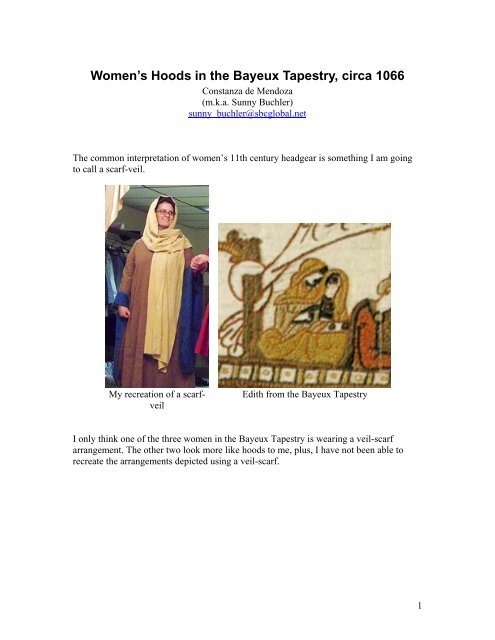You also want an ePaper? Increase the reach of your titles
YUMPU automatically turns print PDFs into web optimized ePapers that Google loves.
Women’s <strong>Hoods</strong> in <strong>the</strong> <strong>Bayeux</strong> <strong>Tapestry</strong>, circa 1066<br />
Constanza de Mendoza<br />
(m.k.a. Sunny Buchler)<br />
sunny_buchler@sbcglobal.net<br />
The common interpretation <strong>of</strong> women’s 11th century headgear is something I am going<br />
to call a scarf-veil.<br />
My recreation <strong>of</strong> a scarfveil<br />
Edith from <strong>the</strong> <strong>Bayeux</strong> <strong>Tapestry</strong><br />
I only think one <strong>of</strong> <strong>the</strong> three women in <strong>the</strong> <strong>Bayeux</strong> <strong>Tapestry</strong> is wearing a veil-scarf<br />
arrangement. The o<strong>the</strong>r two look more like hoods to me, plus, I have not been able to<br />
recreate <strong>the</strong> arrangements depicted using a veil-scarf.<br />
1
Aelfgyva in <strong>the</strong> <strong>Bayeux</strong> <strong>Tapestry</strong><br />
Fleeing Woman in <strong>the</strong> <strong>Bayeux</strong> <strong>Tapestry</strong><br />
Years ago I tried to adjust a "standard" hood pattern (see table on <strong>the</strong> next page) to make<br />
one <strong>of</strong> <strong>the</strong>se hoods. The attempt was an abysmal failure - <strong>the</strong> "standard" hood patterns<br />
aim to be flat across <strong>the</strong> bust & shoulders, <strong>the</strong>y have none <strong>of</strong> <strong>the</strong> folds seen in <strong>the</strong> above<br />
pictures.<br />
2
Standard <strong>Hoods</strong> as described by I. Marc Carlson<br />
http://www.personal.utulsa.edu/%7Emarc-carlson/cloth/hoods.html<br />
According to <strong>the</strong> typology given in Nockert, Type 1 <strong>Hoods</strong> are<br />
typified as<br />
"Hood and liripipe cut in one piece. Tailored neck seam.<br />
Large cape (about 30 cm long) with diagonally cut line<br />
in <strong>the</strong> center, front and back. Gore inserted in <strong>the</strong> middle<br />
<strong>of</strong> both front and back. Wide neck (65 cm approx). Long<br />
liripipe (90 cm). Liripipe 3.5 cm wide."<br />
There is one example <strong>of</strong> this type <strong>of</strong> hood; <strong>the</strong> Bocksten hood. 1<br />
According to <strong>the</strong> typology given in Nockert, Type 2 <strong>Hoods</strong> are<br />
typified as<br />
"Hood cut in two equal parts, with a tailored, slightly<br />
ridged seam above <strong>the</strong> skull. Upper part <strong>of</strong> liripipe<br />
usually cut in one piece with <strong>the</strong> hood. Large cape (20-<br />
33 cm long). Long liripipe (60-84 cm). Liripipe width<br />
varies between 1.4 and 5 cm."<br />
There is also a gore in <strong>the</strong> front, and sometimes in <strong>the</strong> back, and<br />
a somewhat tailored neck seam. This group is made up from<br />
four hoods from Herjolfsnes, and comprises Norlund's "Type I":<br />
no. 65, no. 66, no. 67, and no. 70. The major difference between<br />
<strong>the</strong> Nockert Type 1 and 2 is <strong>the</strong> existance <strong>of</strong> a seam separating<br />
<strong>the</strong> side pieces. 2<br />
According to <strong>the</strong> typology given in Nockert, Type 3 <strong>Hoods</strong> are<br />
typified as<br />
"Hood cut in two equal parts, with a seam above <strong>the</strong><br />
skull. Liripipe cut separately. Short cape (10-15 cm<br />
long) with diagonally cut neck and gore inserted on each<br />
shoulder. Narrow Neck (43-47 cm). Liripipe length<br />
varies between 47 and 68 cm, width 2-6 cm."<br />
This group is made up from eleven hoods from Herjolfsnes, and<br />
comprises Norlund's "Type II": no. 65, no. 71, no. 72, no. 73, no.<br />
75, no. 76, no. 77, no. 78, no. 79, and no. 80. Cutting <strong>the</strong> hood as<br />
a piece with <strong>the</strong> liripipe would <strong>the</strong>n include London Hood no.174.<br />
3<br />
This hood type is not seen in Nockert's Typology.<br />
There are two examples <strong>of</strong> a Type 4 hood; <strong>the</strong> London Hood<br />
no.246/BC72 , and London Hood no.247 4<br />
1 http://www.personal.utulsa.edu/%7Emarc-carlson/cloth/hoodtp1.html<br />
2 http://www.personal.utulsa.edu/%7Emarc-carlson/cloth/hoodtp2.html<br />
3 http://www.personal.utulsa.edu/%7Emarc-carlson/cloth/hoodtp3.html<br />
4 http://www.personal.utulsa.edu/%7Emarc-carlson/cloth/hoodtp4.html<br />
3
So I decided to get a modern hijab to see how those worked. Much to my disappointment<br />
<strong>the</strong> one I ordered was made <strong>of</strong> stretchy material, however it did inspire me to something<br />
that I think works:<br />
This construction hypo<strong>the</strong>sis requires <strong>the</strong> use <strong>of</strong> a band tied around <strong>the</strong> forehead - that’s<br />
good because headbands appear in <strong>the</strong> wills! They even occasionally appear in <strong>the</strong> art -<br />
now that I have a better understanding <strong>of</strong> what I'm looking at. With just <strong>the</strong> scarf-veil a<br />
headband is unnecessary, so <strong>the</strong> references confused me, but if <strong>the</strong>y are used for hoods,<br />
<strong>the</strong>n <strong>the</strong>se references make sense! Also, my new version <strong>of</strong> <strong>the</strong> hood can be pulled down<br />
across <strong>the</strong> shoulders like Aelfgyva's (although possibly <strong>the</strong> bottom needs to be wider for<br />
me):<br />
Aelfgyva in <strong>the</strong> <strong>Bayeux</strong><br />
<strong>Tapestry</strong><br />
Even better - using a double arrangement <strong>of</strong> headbands, you can get <strong>the</strong> multi-layered<br />
version seen in <strong>the</strong> 10 th century art. Granted <strong>the</strong> art is quite stylized, however, all those<br />
sketchy lines have always made me think <strong>of</strong> FOLDS:<br />
4
Late 900s, Prudentius,<br />
Psychomachia. Ostentation<br />
throws <strong>of</strong>f her finery as she<br />
prepares to flee from <strong>the</strong><br />
Virtues. 5<br />
I can make an argument for <strong>the</strong> pattern as well; it's a simple shape too - a trapezoid sewn<br />
into a truncated cone. No advanced fitting techniques required. It is very fabric efficient<br />
as well, presuming it’s made from a narrow width <strong>of</strong> fabric (which can be woven on oneperson<br />
looms). If it’s cut with a half-gore to make <strong>the</strong> angled ends, <strong>the</strong>re is absolutely no<br />
fabric waste.<br />
5 Picture reproduced on page 25 <strong>of</strong> Margaret Scott's Medieval Dress & Fashion. For more picture I<br />
recommend http://www.uvm.edu/%7Ehag/rhuddlan/images/<br />
5
Pattern<br />
Possible cutting layout<br />
I tried both 24” and 33” width <strong>of</strong> fabric, <strong>the</strong> wider one is easier for <strong>the</strong> multi-layered<br />
version, but o<strong>the</strong>r <strong>the</strong>n that it doesn't make much difference.<br />
Oh, and in case you really want to know, <strong>the</strong> headbands look like this:<br />
6
Headband for <strong>the</strong> simple version - I needed<br />
to pin <strong>the</strong> hood at <strong>the</strong> center <strong>of</strong> <strong>the</strong> forehead,<br />
o<strong>the</strong>rwise <strong>the</strong>re's a peak at <strong>the</strong> top.<br />
Multiple headbands for <strong>the</strong> multi-layered<br />
version. When wearing <strong>the</strong> hood I put a pin<br />
at <strong>the</strong> top <strong>of</strong> <strong>the</strong> head to keep <strong>the</strong> folds from<br />
falling back, and two on ei<strong>the</strong>r side <strong>of</strong> <strong>the</strong><br />
forehead to keep <strong>the</strong> front in place.<br />
7






